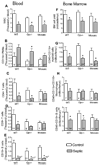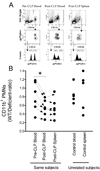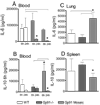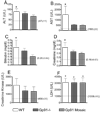Female X-chromosome mosaicism for NOX2 deficiency presents unique inflammatory phenotype and improves outcome in polymicrobial sepsis
- PMID: 21502376
- PMCID: PMC3098917
- DOI: 10.4049/jimmunol.1100205
Female X-chromosome mosaicism for NOX2 deficiency presents unique inflammatory phenotype and improves outcome in polymicrobial sepsis
Abstract
Cellular X-chromosome mosaicism, which is unique to females, may be advantageous during pathophysiological challenges compared with the single X-chromosome machinery of males, and it may contribute to gender dimorphism in the inflammatory response. We tested the hypothesis of whether cellular mosaicism for the X-linked gp91phox (NOX2) deficiency, the catalytic component of the superoxide anion-generating NADPH oxidase complex, is advantageous during polymicrobial sepsis. Deficient, wild-type (WT), and heterozygous/mosaic mice were compared following polymicrobial sepsis initiated by cecal ligation and puncture. Compared with WT littermates, sepsis-induced mortality was improved in deficient mice, as well as in mosaic animals carrying both deficient and WT phagocyte subpopulations. In contrast, blood bacterial counts were greatest in deficient mice. Consistent with poor survival, WT mice also showed the most severe organ damage following sepsis. In mosaic animals, the deficient neutrophil subpopulations displayed increased organ recruitment and elevated CD11b membrane expression compared with WT neutrophil subpopulations within the same animal. The dynamics of sepsis-induced blood and organ cytokine content and WBC composition changes, including lymphocyte subsets in blood and bone marrow, showed differences among WT, deficient, and mosaic subjects, indicating that mosaic mice are not simply the average of the deficient and WT responses. Upon oxidative burst, interchange of oxidants between WT and deficient neutrophil subpopulations occurred in mosaic mice. This study suggests that mice mosaic for gp91phox expression have multiple advantages compared with WT and deficient mice during the septic course.
Figures









References
-
- Liu PY, Death AK, Handelsman DJ. Androgens and cardiovascular disease. Endocr.Rev. 2003;24:313–340. - PubMed
-
- Chen CC, Parker CR., Jr Adrenal androgens and the immune system. Semin.Reprod.Med. 2004;22:369–377. - PubMed
-
- Angele MK, Schwacha MG, Ayala A, Chaudry IH. Effect of gender and sex hormones on immune responses following shock. Shock. 2000;14:81–90. - PubMed
-
- Kovacs EJ, Messingham KA, Gregory MS. Estrogen regulation of immune responses after injury. Mol.Cell Endocrinol. 2002;193:129–135. - PubMed
-
- Choudhry MA, Bland KI, Chaudry IH. Gender and susceptibility to sepsis following trauma. Endocr.Metab Immune.Disord.Drug Targets. 2006;6:127–135. - PubMed
Publication types
MeSH terms
Substances
Grants and funding
LinkOut - more resources
Full Text Sources
Molecular Biology Databases
Research Materials
Miscellaneous

